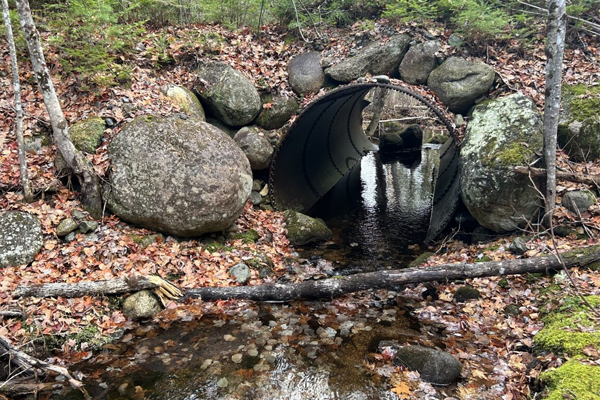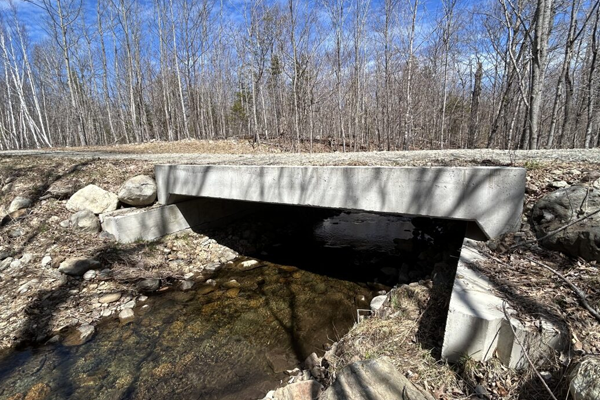
NPS/ Anne Longman What is Aquatic Passage?Aquatic passage refers to the movement of animals through waterways in order to complete their life cycles. Man-made barriers such as roads, culverts, and dams often block natural waterways, disrupting this process. Barriers that completely block waterways, such as elevated culverts, can be fatal to species of fish that require upstream migration. Barriers don’t always have to be physical. Human presence can block aquatic passage in other ways, as in fluctuating water temperature or chemical runoff. These variables often make survival impossible. Although the East Branch of the Penobscot River, which runs directly through Katahdin Woods and Waters National Monument, is one of the least developed watersheds in the continental United States, culverts and bridges still affect numerous streams throughout the monument and surrounding area. The Penobscot River is home to 11 migratory fish species, with three listed under the Endangered Species Act, some of which travel as far upstream as the monument. The monument serves to protect and preserve the land and waters within its boundaries, including these crucial members of the aquatic ecosystem. 
NPS/ Anne Longman Why is Aquatic Passage Important?Healthy waterways make for a healthy monument! Allowing fish and other aquatic animals safe passage to breeding grounds ensures stable populations, healthy ecosystems, and balanced environments. Waterways need to exist in natural, continuous flow in order to properly support the life cycles of aquatic organisms. You might think of the animals that eat fish, like birds. If birds cannot rely on stable fish populations for food, they will turn elsewhere. If birds begin eating more frogs, the frog population will diminish. When the frog population diminishes, the bug population increases. This ripple effect from the change in one species to another is called a trophic cascade. Major trophic cascades, caused by the sudden introduction or exclusion of specific animal species on closed ecosystems, can have sustained, long-lasting impacts. Sometimes, these impacts are positive, such as the famous trophic cascade at Yellowstone National Park following the introduction of wolves, which led to the stabilization of other species within the park. Other times, the impact can be detrimental. An important part of the monument’s work is creating healthy ecosystems without man-made interference, giving animals the best chance at survival, and allowing for natural, uninterrupted processes to take place. 
NPS/ Anne Longman Problems and SolutionsStaff at Katahdin Woods and Waters National Monument work hard to ensure that waterways allow safe passage for all aquatic animals by assessing man-made barriers and removing them, when necessary. Culverts and bridges are maintained to reduce blockage, replaced with larger culverts and bridges to ensure water flows freely, or removed if they are unnecessary. 
NPS/ Kiah Walker Take a Look at this Culvert!What might be wrong with this culvert? Although it allows for water flow, the width of the culvert is narrow compared to the natural bank. This causes an unnatural diversion of water and makes it more difficult for fish to swim naturally through this passage. It may also cause flooding or erosion in times of high water. 
NPS/ Kiah Walker ... What About this Bridge?Can you spot what's wrong with it? If you said nothing, you are right! This bridge serves as an example of proper waterflow. The bridge is wider than the banks on each side of the waterway, and animals can move freely through the space without increased effort or stress. A Project in ActionLearn more about a major aquatic passage project completed by U.S. Fish and Wildlife at Saccarappa Falls in Westbrook, Maine, approximately 3 hours from Katahdin Woods and Waters National Monument.

NPS/ Anne Longman What do you see?Next time you encounter a man-made obstruction, think about how it is built. Inspect the water flow underneath a bridge or look inside a culvert. Does it allow for proper waterflow? How might it be redesigned to allow for safer passage? If you were a fish, could you get through? Fish and other aquatic animals can be seen in the many waterways of KAWW, with popular viewing sites including Lunksoos Boat Launch, Lynx Pond, Deasey Pond, and Kimball Deadwater. Swim on! Learn More about Aquatic Ecosystems in Maine |
Last updated: November 22, 2024
